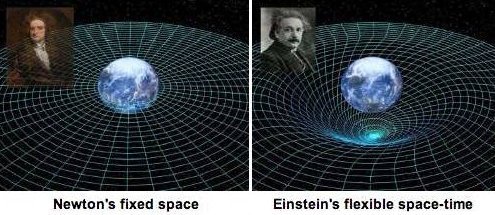Dive into your creative stream
Gravity - Blog Posts
What are Gravitational Waves?
Today, the National Science Foundation (NSF) announced the detection of gravitational waves by the Laser Interferometer Gravitational-Wave Observatory (LIGO), a pair of ground-based observatories. But...what are gravitational waves? Let us explain:

Gravitational waves are disturbances in space-time, the very fabric of the universe, that travel at the speed of light. The waves are emitted by any mass that is changing speed or direction. The simplest example is a binary system, where a pair of stars or compact objects (like black holes) orbit their common center of mass.

We can think of gravitational effects as curvatures in space-time. Earth’s gravity is constant and produces a static curve in space-time. A gravitational wave is a curvature that moves through space-time much like a water wave moves across the surface of a lake. It is generated only when masses are speeding up, slowing down or changing direction.
Did you know Earth also gives off gravitational waves? Earth orbits the sun, which means its direction is always changing, so it does generate gravitational waves, although extremely weak and faint.
What do we learn from these waves?
Observing gravitational waves would be a huge step forward in our understanding of the evolution of the universe, and how large-scale structures, like galaxies and galaxy clusters, are formed.
Gravitational waves can travel across the universe without being impeded by intervening dust and gas. These waves could also provide information about massive objects, such as black holes, that do not themselves emit light and would be undetectable with traditional telescopes.

Just as we need both ground-based and space-based optical telescopes, we need both kinds of gravitational wave observatories to study different wavelengths. Each type complements the other.
Ground-based: For optical telescopes, Earth’s atmosphere prevents some wavelengths from reaching the ground and distorts the light that does.
Space-based: Telescopes in space have a clear, steady view. That said, telescopes on the ground can be much larger than anything ever launched into space, so they can capture more light from faint objects.
How does this relate to Einstein’s theory of relativity?
The direct detection of gravitational waves is the last major prediction of Einstein’s theory to be proven. Direct detection of these waves will allow scientists to test specific predictions of the theory under conditions that have not been observed to date, such as in very strong gravitational fields.

In everyday language, “theory” means something different than it does to scientists. For scientists, the word refers to a system of ideas that explains observations and experimental results through independent general principles. Isaac Newton's theory of gravity has limitations we can measure by, say, long-term observations of the motion of the planet Mercury. Einstein's relativity theory explains these and other measurements. We recognize that Newton's theory is incomplete when we make sufficiently sensitive measurements. This is likely also true for relativity, and gravitational waves may help us understand where it becomes incomplete.
Make sure to follow us on Tumblr for your regular dose of space: http://nasa.tumblr.com
5 Fun Things To Do Without Gravity
Astronauts onboard the International Space station are typically active for at least 9 1/2 hours per day doing science, exercising and maintaining systems. Excluding scheduled time for sleep and lunch, astronauts have only 4 hours of free time during the work week, and that includes time for meals and general hygiene.
Even with a loaded calendar, the few who have such an opportunity to live in the microgravity environment find ways to make the most of this experience. Here are just a few of their favorite things about living in space:
Flying

One of the most self-explanatory (and most fun!) aspects of living in space for the astronauts is “flying”. In space there is no up or down, so there is no floor or ceiling. There are rails throughout the space station that astronauts use to push themselves among the modules.
Eating

Astronauts actually describe the food on the space station as quite tasty! In part, that’s because they have a large role in choosing their own meals. Over time though, a lot of astronauts experience desensitized taste buds from the shifting fluid to their head. Toward the end of their expedition, spicy foods tend to be their favorites because of this phenomenon.
Drinking

Liquid behaves very differently in space than it does on Earth. Astronauts cannot simply pour a cup of coffee into a mug. Without gravity, it would stick to the walls of the cup and would be very difficult to sip. Most of the time, astronauts fill a bag with liquid and use a special straw with a clamp to keep the contents from flying out.
Playing Games

The space station crew occasionally gets downtime which they can spend however they please. Sometimes they watch a movie, read a book or take photos of Earth from the Cupola windows. Other times they invent games to play with each other, and each crew tends to come up with new games. Sometimes it can be hitting a target, flying from one end of the station to the other fastest or playing zero-gravity sports.
Going Out For A Walk

Preparing and executing a spacewalk can take around 8 to 12 hours, and can be a jam-packed schedule. Spacewalkers have to be focused on the task at hand and sticking to the timeline. That said, they can still catch a spare moment to see the Earth 250 miles below. Many astronauts describe that view from a spacewalk as one of the most beautiful sights in their lives.
Watch Commander Scott Kelly and Flight Engineer Kjell Lindgren perform a spacewalk on Oct. 28 at 8:15 a.m. EDT live on NASA Television.
Make sure to follow us on Tumblr for your regular dose of space: http://nasa.tumblr.com